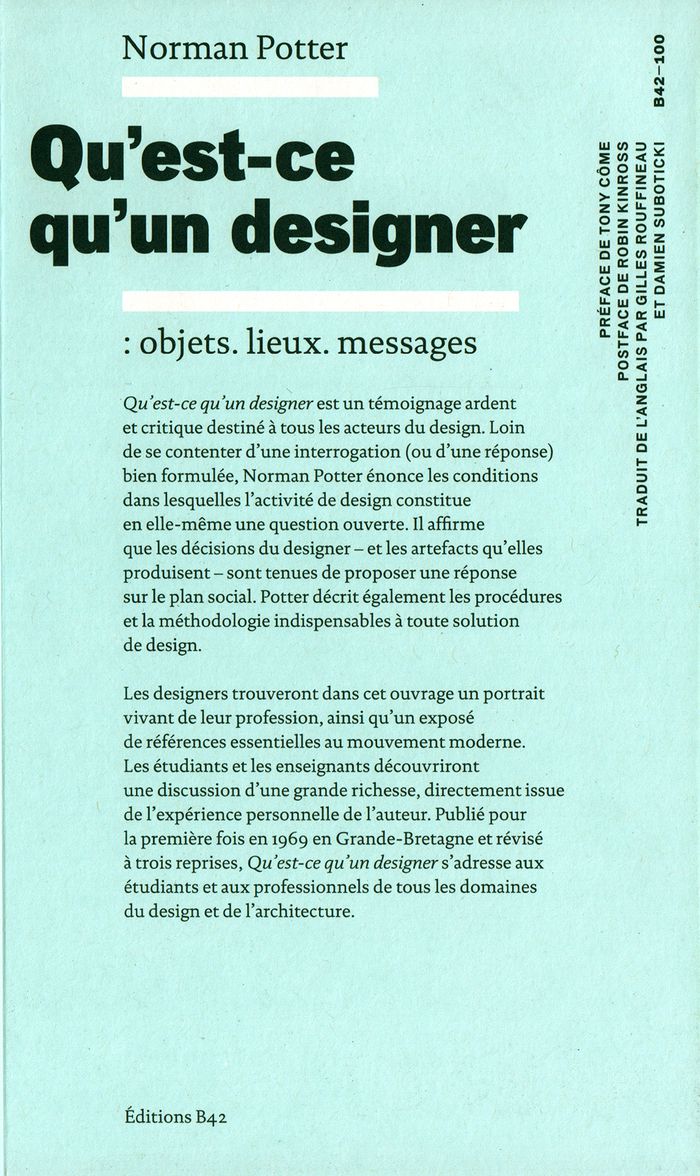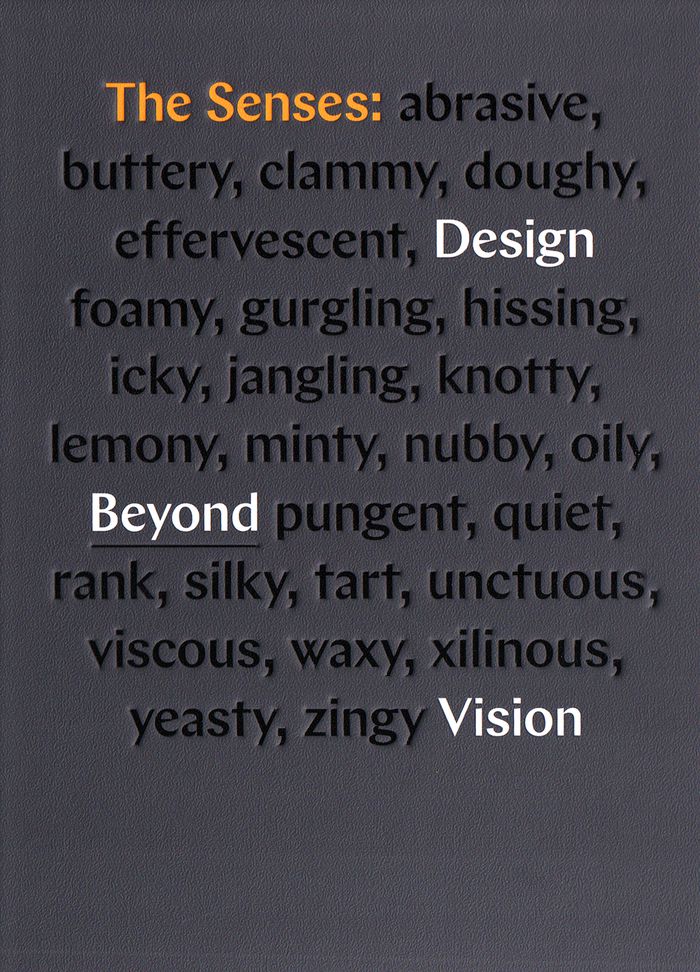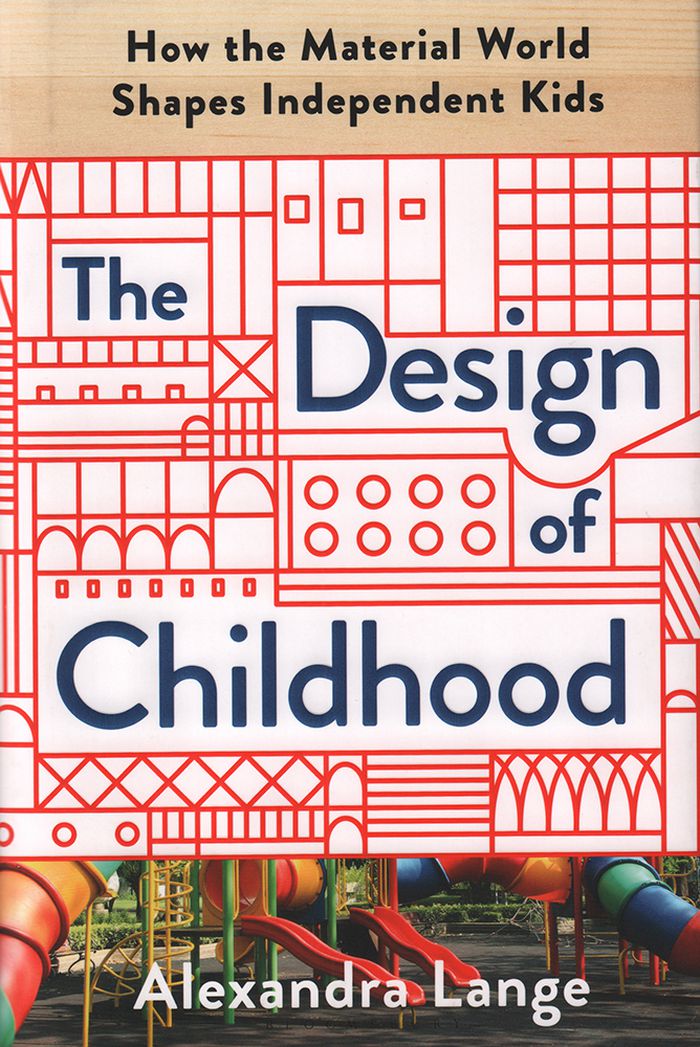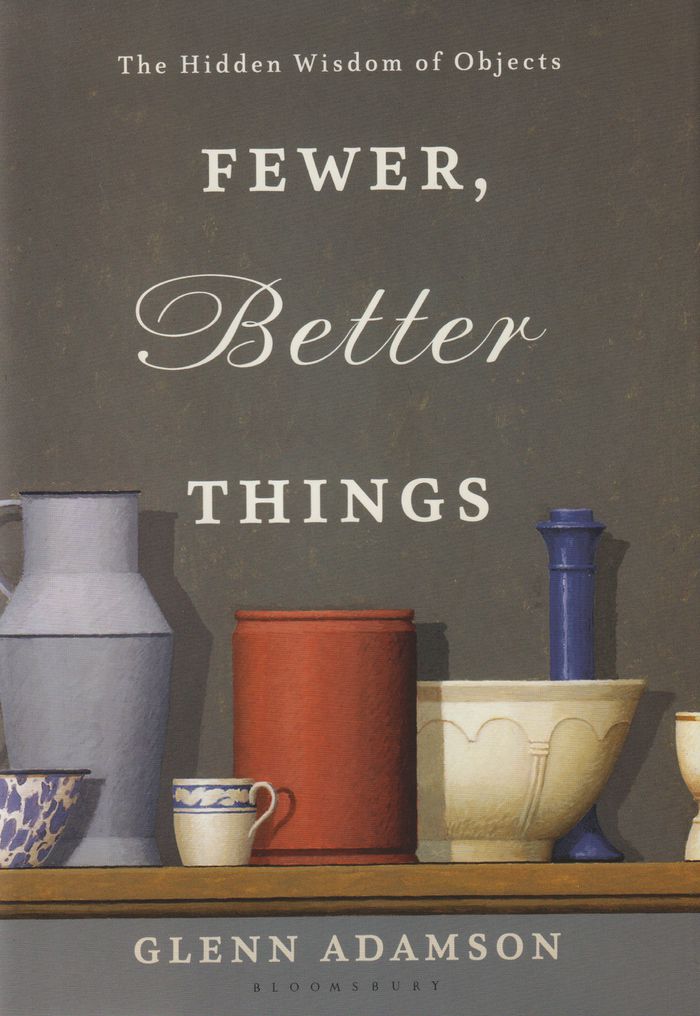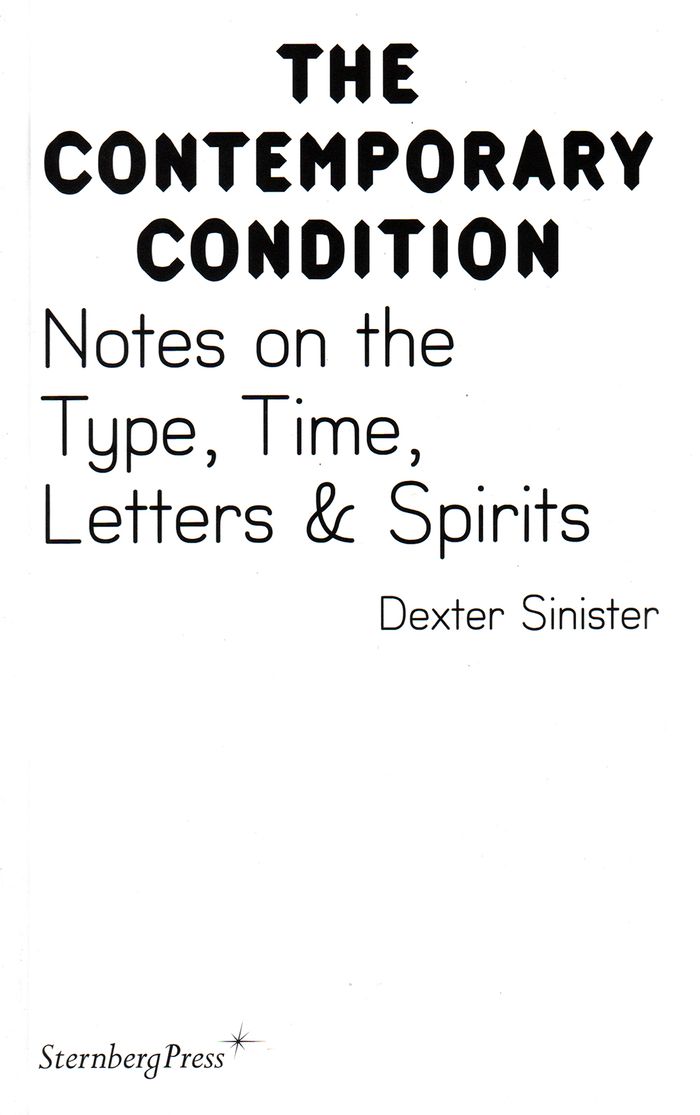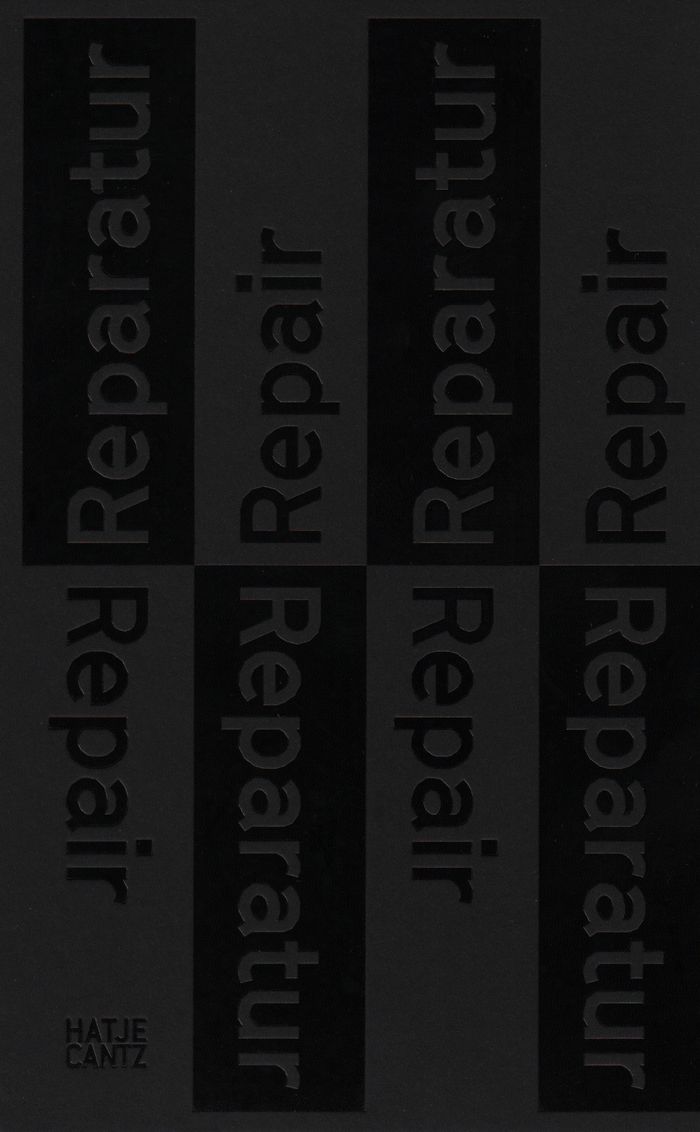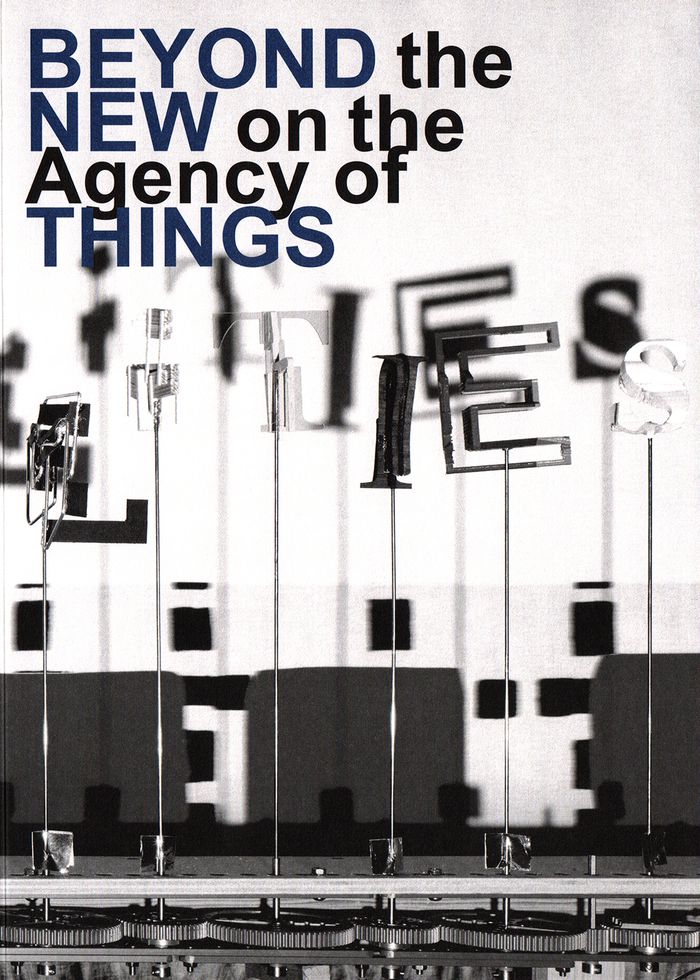.TXT, no. 3
$22.95
(available to order)
Summary:
Parmi les publications qui engagent une réflexion sur la diversité des pratiques du design graphique, .txt se présente comme un espace d’écriture proposé aux étudiants de l’option « design graphique » de l’École supérieure d’art et design Grenoble-Valence. Selon une célèbre devise Shadock : « Il vaut mieux pomper même s’il ne se passe rien que risquer qu’il se passe(...)
.TXT, no. 3
Actions:
Price:
$22.95
(available to order)
Summary:
Parmi les publications qui engagent une réflexion sur la diversité des pratiques du design graphique, .txt se présente comme un espace d’écriture proposé aux étudiants de l’option « design graphique » de l’École supérieure d’art et design Grenoble-Valence. Selon une célèbre devise Shadock : « Il vaut mieux pomper même s’il ne se passe rien que risquer qu’il se passe quelque chose de pire en ne pompant pas. » En termes de pédagogie du design, cela pourrait donner : il vaut mieux imaginer/rêver/penser même s’il ne se passe rien que risquer qu’il se passe quelque chose de pire en n’imaginant/ne rêvant/ne pensant pas. Pour inventer. Et pas seulement pour innover. Transformer. Et pas seulement accommoder. Imaginer d’autres pratiques du design, d’autres modes de production, d’autres paramètres d’analyse. Cette imagination, ces rêves, ces pensées sont celles d’étudiants dont les textes publiés dans ce troisième volume .txt témoignent aussi d’une approche critique de notre monde.
Design Theory
$35.95
(available to order)
Summary:
"Qu’est-ce qu’un designer" est un témoignage ardent et critique destiné à tous les acteurs du design. Loin de se contenter d’une interrogation (ou d’une réponse) bien formulée, Norman Potter énonce les conditions dans lesquelles l’activité de design constitue en elle-même une question ouverte. Il affirme que les décisions du designer – et les artefacts qu’elles produisent(...)
Qu'est-ce qu'un designer : objets, lieux, message, 2e édition
Actions:
Price:
$35.95
(available to order)
Summary:
"Qu’est-ce qu’un designer" est un témoignage ardent et critique destiné à tous les acteurs du design. Loin de se contenter d’une interrogation (ou d’une réponse) bien formulée, Norman Potter énonce les conditions dans lesquelles l’activité de design constitue en elle-même une question ouverte. Il affirme que les décisions du designer – et les artefacts qu’elles produisent – sont tenues de proposer une réponse sur le plan social. Potter décrit également les procédures et la méthodologie indispensables à toute solution de design. Les designers trouveront dans cet ouvrage un portrait vivant de leur profession, ainsi qu’un exposé de références essentielles au mouvement moderne. Les étudiants et les enseignants découvriront une discussion d’une grande richesse, directement issue de l’expérience personnelle de l’auteur. Publié pour la première fois en 1969 en Grande-Bretagne et révisé à trois reprises, "Qu’est-ce qu’un designer" s’adresse aux étudiants et aux professionnels de tous les domaines du design et de l’architecture.
Design Theory
$42.00
(available to order)
Summary:
A powerful reminder to anyone who thinks design is primarily a visual pursuit, "The Senses" accompanies a major exhibition at the Cooper-Hewitt Smithsonian Design Museum that explores how space, materials, sound, and light affect the mind and body. Learn how contemporary designers, including Petra Blaisse, Bruce Mau, Malin+Goetz and many others, engage sensory experience.(...)
The senses: design beyond vision
Actions:
Price:
$42.00
(available to order)
Summary:
A powerful reminder to anyone who thinks design is primarily a visual pursuit, "The Senses" accompanies a major exhibition at the Cooper-Hewitt Smithsonian Design Museum that explores how space, materials, sound, and light affect the mind and body. Learn how contemporary designers, including Petra Blaisse, Bruce Mau, Malin+Goetz and many others, engage sensory experience. Multisensory design can solve problems and enhance life for everyone, including those with sensory disabilities. Featuring thematic essays on topics ranging from design for the table to tactile graphics, tactile sound, and visualizing the senses, this book is a call to action for multisensory design practice.
Design Theory
$15.95
(available in store)
Summary:
Quel rapport, autre qu'instrumental ou de « maîtrise », le designer peut-il entretenir avec les techniques qu'il exerce ? Quelles « façons de faire » cultivons-nous quand nous avons de la considération pour les cultures techniques ? Et plus généralement qu'est-ce qui fait culture technique aujourd'hui ? Telles sont les questions dont témoigne cette édition. Sous le nom (...)
Par nos propres efforts : documenter, lire, opérer et montrer les « manières de faire »
Actions:
Price:
$15.95
(available in store)
Summary:
Quel rapport, autre qu'instrumental ou de « maîtrise », le designer peut-il entretenir avec les techniques qu'il exerce ? Quelles « façons de faire » cultivons-nous quand nous avons de la considération pour les cultures techniques ? Et plus généralement qu'est-ce qui fait culture technique aujourd'hui ? Telles sont les questions dont témoigne cette édition. Sous le nom repris d'une publication cubaine des années 1990, le document de restitution articule des documentations de la journée d'étude qui a réuni Caroline Maniaque-Benton et Pierre-Damien Huyghe ; des reproductions du corpus de publications de natures diverses qui documentent et diffusent la technique réunis pour l'occasion ; et des traces de deux ateliers de production : l'un consacré à l'interprétation de la grammaire de l'ouvrage emblématique d'Enzo Mari « Proposta per un'autoprogettazione », l'autre dédié à la réalisation d'un appareil de transformation / fabrication sous l'animation de l'activiste de la low technologie et de l'autonomie énergétique Barnabé Chaillot.
Design Theory
$40.00
(available to order)
Summary:
From building blocks to city blocks, an eye-opening exploration of how children's playthings and physical surroundings affect their development. What do youngsters lose when seesaws are deemed too dangerous and slides are designed primarily for safety? How can the built environment help children cultivate self-reliance? Alexandra Lange reveals the surprising histories(...)
The design of childhood: how the material world shapes kids
Actions:
Price:
$40.00
(available to order)
Summary:
From building blocks to city blocks, an eye-opening exploration of how children's playthings and physical surroundings affect their development. What do youngsters lose when seesaws are deemed too dangerous and slides are designed primarily for safety? How can the built environment help children cultivate self-reliance? Alexandra Lange reveals the surprising histories behind the human-made elements of our children's pint-size landscape. Her fascinating investigation shows how the seemingly innocuous universe of stuff affects kids' behavior, values, and health, often in subtle ways. And she reveals how years of decisions by toymakers, architects, and urban planners have helped--and hindered--American youngsters' journeys toward independence. Seen through Lange's eyes, everything from the sandbox to the street becomes vibrant with buried meaning.
Design Theory
$36.00
(available to order)
Summary:
From the former director of the Museum of Arts and Design in New York, a timely and passionate case for the role of the well-designed object in the digital age. Curator and scholar Glenn Adamson opens "Fewer, Better Things" by contrasting his beloved childhood teddy bear to the smartphones and digital tablets children have today. He laments that many children and adults(...)
Fewer, better things. The hidden wisdom of objects
Actions:
Price:
$36.00
(available to order)
Summary:
From the former director of the Museum of Arts and Design in New York, a timely and passionate case for the role of the well-designed object in the digital age. Curator and scholar Glenn Adamson opens "Fewer, Better Things" by contrasting his beloved childhood teddy bear to the smartphones and digital tablets children have today. He laments that many children and adults are losing touch with the material objects that have nurtured human development for thousands of years. The objects are still here, but we seem to care less and know less about them. "Fewer, Better Things" explores the history of craft in its many forms, explaining how raw materials, tools, design, and technique come together to produce beauty and utility in handmade or manufactured items.
Design Theory
$22.95
(available to order)
Summary:
Three interconnected palimpsest essays recount (1) the backstory of a “meta” font recently updated by Dexter Sinister and used to typeset the Contemporary Condition book series, (2) a broad history of the rationalization of letterforms that considers the same typeface from “a higher point of disinterest,” and (3) a pending proposal for a sundial designed to operate in(...)
Dexer Sinister: Notes on the type, time, letters & spirits
Actions:
Price:
$22.95
(available to order)
Summary:
Three interconnected palimpsest essays recount (1) the backstory of a “meta” font recently updated by Dexter Sinister and used to typeset the Contemporary Condition book series, (2) a broad history of the rationalization of letterforms that considers the same typeface from “a higher point of disinterest,” and (3) a pending proposal for a sundial designed to operate in parallel physical and digital realms. Along the way they contemplate the ambiguous nature of our shared idea of *time* itself.
Design Theory
$53.95
(available to order)
Summary:
Arising from a course on repair at the Faculty of Architecture at the University of Applied Sciences in Munich, this book responds to our culture of disposability and built-in obsolescence, to encourage thinking and making, from product design to architecture.
Repair: encouragement to think and make
Actions:
Price:
$53.95
(available to order)
Summary:
Arising from a course on repair at the Faculty of Architecture at the University of Applied Sciences in Munich, this book responds to our culture of disposability and built-in obsolescence, to encourage thinking and making, from product design to architecture.
Design Theory
$79.00
(available to order)
Summary:
In this engaging new book, design theorist Louise Schouwenberg (born 1954) and designer Hella Jongerius (born 1963) examine the meaning and agency of objects, exploring how things act as mediators between people and the world both in everyday life and in the context of the museum. As technology continues to change these relationships, Schouwenberg and Jongerius(...)
Beyond the new on the agency of things
Actions:
Price:
$79.00
(available to order)
Summary:
In this engaging new book, design theorist Louise Schouwenberg (born 1954) and designer Hella Jongerius (born 1963) examine the meaning and agency of objects, exploring how things act as mediators between people and the world both in everyday life and in the context of the museum. As technology continues to change these relationships, Schouwenberg and Jongerius thoughtfully consider the agency of our objects. Questioning the market's obsession with novelty in design, the authors try to develop criteria for recognizing true cultural innovation. What distinguishes novelty for the sake of novelty from something truly new? Designed by the legendary Irma Boom, the book itself is a love letter to creative design.
Design Theory
$55.95
(available to order)
Summary:
Founded in 2003, Design Observer inscribes its mission on its homepage: Writings about Design and Culture. Since its inception, the site has consistently embraced a broader, more interdisciplinary, and circumspect view of design's value in the world- one not limited by materialism, trends, or the slipperiness of style. Dedicated to the pursuit of originality, imagination,(...)
Culture is not always popular: fifteen years of design observer
Actions:
Price:
$55.95
(available to order)
Summary:
Founded in 2003, Design Observer inscribes its mission on its homepage: Writings about Design and Culture. Since its inception, the site has consistently embraced a broader, more interdisciplinary, and circumspect view of design's value in the world- one not limited by materialism, trends, or the slipperiness of style. Dedicated to the pursuit of originality, imagination, and close cultural analysis, Design Observer quickly became a lively forum for readers in the international design community. Fifteen years, 6,700 articles, 900 authors, and nearly 30,000 comments later, this book is a combination primer, celebration, survey, and salute to a certain moment in online culture.
Design Theory

